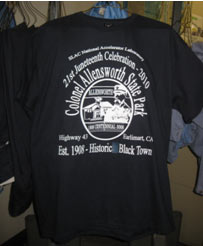

Thursday - June 10, 2010
SLAC Today is
available online at:
http://today.slac.stanford.edu
In this issue:
Methane Enzyme Shows Promise for Fuels
Welcome, New SLACers!
Juneteenth Celebration T-Shirts and Baseball Caps for Sale
 |
 |
|
Thursday - June 10, 2010 |
Methane Enzyme Shows Promise for FuelsMethane is known for being a potent greenhouse gas. However, it also holds excellent potential as an energy source. The trouble is, methane is difficult to store and transport because it is a gas, putting a damper on its use. Since methane will remain a gas under normal conditions, high pressures or cold temperatures are required to transport it. A paper by SSRL users published in Nature last month provides an alternate path to methane-as-fuel: converting it into the liquid, methanol. The study investigates an enzyme, which has sites that contain copper atoms at its center, that can catalyze the conversion of methane into the more transportation-friendly fuel sources. Some of the work for this publication, specifically investigating these copper sites, was done at the Stanford Synchrotron Radiation Lightsource. Timothy Stemmler, a co-author of this study from Wayne State University, came to SSRL to perform state-of-the-art X-ray spectroscopy on this enzyme. "The facilities at SSRL are arguably the best in the world for performing X-ray absorption spectroscopy studies," he said. Using SSRL Beamline 9-3, Stemmler and colleagues probed the enzyme's metal sites to better understand how copper contributes to the chemical reaction. In nature, many chemical processes rely on the assistance of metals to complete similar reactions. "It is the diverse chemical properties of the metal cofactors that allow metalloenzymes to perform such unique chemistry so efficiently," Stemmler said. In this instance, the copper is aiding in the addition of the alcohol group, or "-OH," to methane. The additional of this alcohol group is no small feat−scientists have been trying for years to find an easy way to make this important transition. Stemmler pointed out that many small molecule catalysts can make the methane-to-methanol transition, also known as oxidation, but none with the efficiency of this enzyme. Welcome, New SLACers!SLAC welcomed 17 new staff members at last Thursday's New Employee Orientation. They are, from the left: Christian Perinet
Please join us in congratulating our new staff as they embark on their pathway to success at SLAC! Juneteenth Celebration T-Shirts and Baseball Caps for Sale T-shirt design. (Photo courtesy Michelle Smith.)
The Juneteenth Celebration is on Friday, June 18 from 11:30 a.m. to 2 p.m. Food will be served at Noon. If you would like to purchase a Juneteenth 2010 T-Shirt or Baseball Cap, please e-mail Michelle Smith. Please place your order by Monday, June 14 (sorry about the rush). You can order now and pay with cash or check payable to Michelle Strand next week. T-Shirts and caps will be ready for pick-up on Thursday, June 17 between 3:45 and 5 p.m. at the Linear Cafe outdoor patio area or during Juneteenth. For prices and more details, see the full announcement... |
Events
Access (see all)Announcements
|
|
| | ||
|
|
||
 <%
Response.AddHeader "Last-modified", getArticleDate()
'Response.AddHeader "Last-modified","Mon, 01 Sep 1997 01:03:33 GMT"
'Monday, December 06, 2010
%>
<%
Response.AddHeader "Last-modified", getArticleDate()
'Response.AddHeader "Last-modified","Mon, 01 Sep 1997 01:03:33 GMT"
'Monday, December 06, 2010
%>View online at http://today.slac.stanford.edu/. |
||